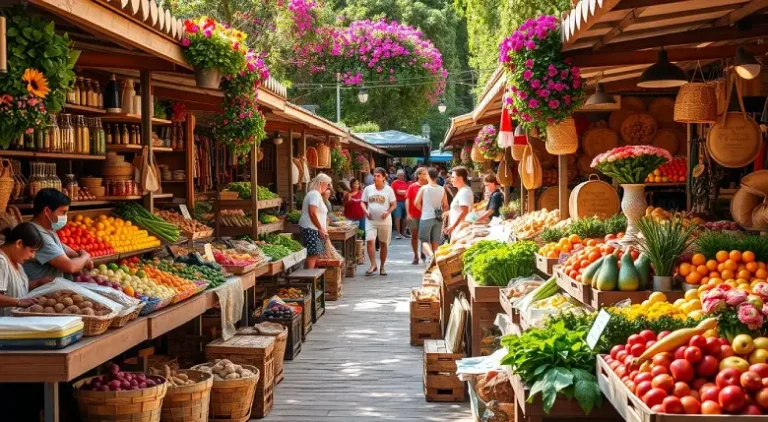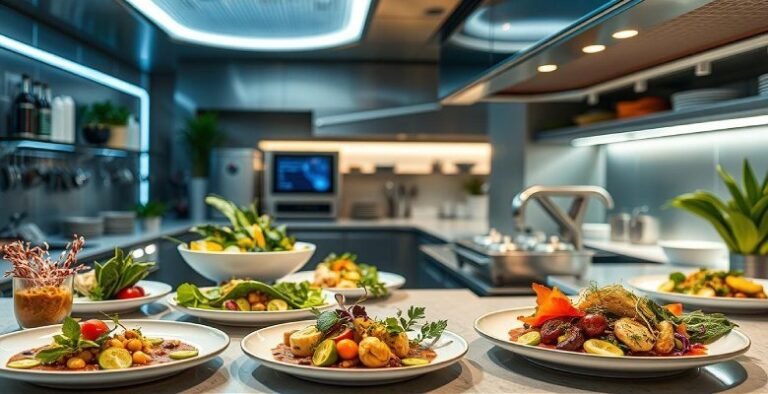Gastronomy in 2025: Exploring New Culinary Frontiers
Table of Contents
As you dive into the culinary trends of 2025, you’ll find that food tourism is booming. Travelers love to explore local food cultures and traditions. The future of food will bring new cooking methods, sustainable practices, and tech advancements.
With social media, food lovers want to share their dining adventures. The industry is responding with unique and engaging dining experiences. This shows how important culinary trends and the future of food are.
In 2025, expect a focus on local ingredients and food tourism. These trends will be shaped by new cooking techniques. It’s key to keep up with the latest in culinary trends and the future of food.
Key Takeaways
- The future of gastronomy will be shaped by innovative cooking techniques and culinary technology advancements.
- Culinary trends 2025 will emphasize local and regional ingredients, as well as sustainable food practices.
- Immersive and interactive dining experiences will become increasingly popular, driven by social media and food tourism.
- The integration of artificial intelligence in recipe creation will significantly influence future culinary practices and methodologies.
- Innovative cooking techniques, such as molecular cuisine and advanced fermentation, will continue to revolutionize food preparation and consumption.
- The demand for organic ingredients and eco-friendly packaging solutions will drive growth in the industry, reflecting the importance of sustainable alternatives in Italian comfort food.
- The global market for AI in the food industry is expected to reach approximately $2.2 billion by 2025, highlighting the trend towards health-conscious cooking and personalized nutrition technology.
The Evolution of Culinary Trends 2025
In 2025, the world of food is changing fast. New technologies are helping chefs make amazing dishes. People are also focusing more on food that’s good for the planet.
Technology is playing a big role in these changes. The demand for plant-based foods is rising. More restaurants are now zero-waste, showing a big move towards green eating.
Digital Integration in Modern Kitchens
Kitchens today are getting a tech boost. AI helps chefs make new dishes. Personalized nutrition tech gives advice on what to eat.
Some key trends include:
- More use of tech to save time, like QR codes and self-service
- More interest in new cooking methods, like fermentation
- People want to know where their food comes from
AI-Powered Recipe Development
AI is changing how chefs create dishes. It helps them mix flavors and ingredients in new ways. This tech also makes meal plans that fit your diet and tastes.
Revolutionizing Food Production Methods
As you explore the future of food, you’ll see a big change towards sustainable food practices. This shift is because of growing awareness of environmental issues and the need to cut down on food waste. The evolution of cooking methods is also key, focusing on local ingredients, less water and energy, and recycling.
The effect of sustainable food practices on food production is huge. By 2025, sustainability will be a big part of cooking, thanks to more aware consumers and a focus on local resources. Some important trends include:
- More use of plant-based proteins
- Technological innovations, like artificial intelligence in kitchen appliances
- Digital menu systems to make guest experiences better and operations more efficient
As the food industry keeps changing, it’s vital to adopt sustainable food practices and use the evolution of cooking methods in our daily lives. This way, we help make the food system more eco-friendly. We also get the perks of less food waste and better use of resources.
To show how important sustainable food practices are, here are some stats:
| Trend | Expected Impact by 2025 |
|---|---|
| Plant-based proteins | Significant increase in consumption |
| Artificial intelligence in kitchen appliances | Optimized cooking processes, resulting in energy and time savings |
| Digital menu systems | Enhanced guest experiences and improved operational efficiency |
Sustainable Gastronomy: Your Kitchen’s Future Impact
As you dive into the world of food, you’ll see a big change. People now want progressive culinary concepts
Adding cutting-edge gastronomy trends to your kitchen is easy. Try using zero-waste cooking or energy-saving kitchen tools. Also, buying local ingredients can help a lot. It cuts down on carbon emissions and supports local farmers.
Some important ways to make your kitchen more sustainable include:
- Reducing food waste by planning meals better and composting
- Choosing eco-friendly cookware and utensils
- Using energy-saving cooking methods like induction or solar ovens
By choosing sustainable food, you join a big change in cooking. It’s about enjoying food and caring for our planet. Every little change you make can help a lot in the future.
| Sustainable Gastronomy Strategies | Benefits |
|---|---|
| Zero-waste cooking technologies | Reduces food waste, conserves resources |
| Energy-efficient culinary equipment | Lowers energy consumption, reduces carbon footprint |
| Local sourcing through smart systems | Supports local farmers, promotes community development |
Innovative Cooking Techniques Reshaping Home Cooking
Exploring innovative cooking techniques opens up a world of new ways to cook at home. Methods like sous vide and molecular gastronomy make it simpler to whip up complex, tasty meals. With modern food trends on the rise, people are eager to try new flavors and ingredients.
Some top innovative cooking techniques include:
- Fermentation
- Plant-based cooking
- Smoking and curing
These methods are not just changing cooking habits but also how we view food. Thanks to modern food trends, home cooking is now more thrilling and varied.
As you dive deeper into innovative cooking techniques, you’ll see endless possibilities. With the right tools and ingredients, you can craft dishes that are both tasty and beautiful. Whether you’re an experienced chef or just starting out, modern food trends and innovative cooking techniques will push you to new culinary heights.
| Cooking Technique | Description |
|---|---|
| Sous Vide | Cooking food sealed in airtight bags in a water bath |
| Molecular Gastronomy | Applying scientific principles to cooking |
| Fermentation | Allowing food to break down naturally by microorganisms |
The Intersection of Virtual Reality and Dining Experiences
Virtual reality is changing how we enjoy food. It brings new ways to learn about cooking and taste different cuisines. Now, diners can take part in interactive cooking classes and explore global flavors.
Imagine tasting dishes from all over the world without leaving home. Thanks to virtual reality, this is now possible. Restaurants are also using it to let customers see their meals being made.
Wendy’s and Taco Bell are using virtual reality to reach more people. This trend is growing, with more places adding virtual reality to their dining experiences.
The food industry is always getting better, thanks to new tech. We’ll see more cool things like interactive cooking and immersive dining. The future of eating out is exciting.
| Technology | Description |
|---|---|
| Virtual Reality | Enhances dining experiences with interactive and immersive experiences |
| Augmented Reality | Provides 3D representations of meals and nutritional information |
| Artificial Intelligence | Helps with meal planning and recipe development |
Conclusion: Embracing the Future of Food
The future of food in 2025 looks bright with new culinary techniques and sustainable practices. Virtual reality and regenerative viticulture are changing the game. Restaurants and home cooks are now using local, seasonal ingredients and global flavors for unique meals.
The future of gastronomy is full of promise. We’ll see more personalized nutrition, AI recipes, and green cooking tools. As culinary trends 2025 grow, expect more focus on being green, sharing cultures, and tech in the kitchen. Joining these trends can make your food experiences better, greener, and more connected.



